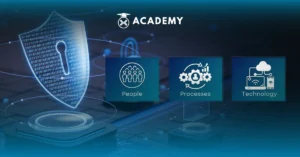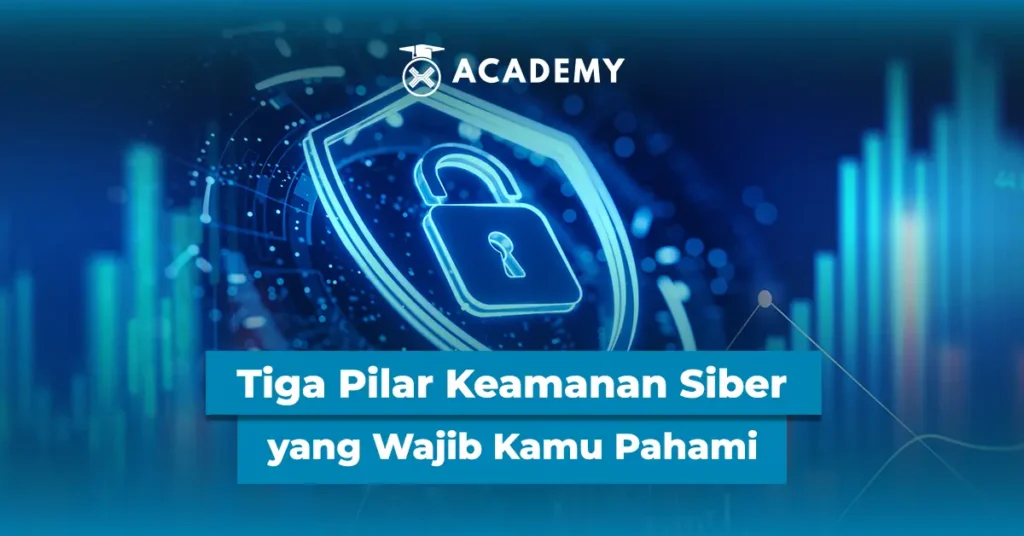Cybersecurity isn’t just a concern for large corporations; it’s also crucial for anyone holding digital assets like crypto. While the blockchain world is transparent, it’s still vulnerable to attacks.
For example, the Ronin Network hack, which resulted in hundreds of millions of dollars in losses, serves as a reminder that protecting personal data and wallets is essential for every user.
What is Cybersecurity?

Cybersecurity is the effort to protect systems, networks, and data from various digital threats, such as hacking, information theft, and malware attacks.
The goal is simple: to ensure data remains secure and can only be accessed by authorized parties.
In the crypto world, examples include phishing attacks that mimic official exchange websites to steal user passwords, or wallet hacks that result in the loss of digital assets.
Therefore, understanding cybersecurity is crucial for anyone active in the digital ecosystem.
The Origins of the Three Pillars of Cybersecurity Concept
The three pillars of cybersecurity concept stems from two main approaches that remain the benchmarks in the world of information security: the CIA Triad and People–Process–Technology.
The CIA Triad, or Confidentiality, Integrity, and Availability, is the foundation of information security theory.
Confidentiality emphasizes the importance of maintaining data confidentiality, Integrity ensures the authenticity and consistency of information, and Availability ensures that data and systems are always accessible when needed.
Meanwhile, People–Process–Technology is a more practical approach and is widely used by modern organizations.
This approach highlights three key aspects of maintaining security: the role of people who are aware of cyber risks, processes governed by policies and procedures, and technology that serves as the primary defense against digital attacks.
These two concepts are often used interchangeably, depending on the context. The CIA Triad itself is more appropriate for technical and data protection areas.
Meanwhile, People–Process–Technology is widely applied at the managerial level to build a security culture within an organization.
What Are the Three Pillars of Cybersecurity?
In the world of digital security, three main pillars are recognized as the foundation for protecting data and systems from various threats: Confidentiality, Integrity, and Availability, or the CIA Triad.
These three pillars complement each other to keep information secure, accurate, and accessible when needed. The following explains these three pillars:
Pillar 1: Confidentiality
This first pillar focuses on ensuring data can only be accessed by authorized parties. This means that sensitive information such as personal identity, financial data, or digital assets must be protected from unauthorized access.
This confidentiality can be maintained through the use of strong passwords, data encryption, and two-factor authentication.
In the context of crypto, this confidentiality principle is realized through private keys. Private keys are the primary keys for accessing and managing digital assets.
Therefore, it is crucial to never share your seed phrase or private key with anyone. Once leaked, crypto assets can be lost irretrievably.
Pillar 2: Integrity
The second pillar, integrity, ensures that data remains intact and unaltered without permission. This means that information stored or transmitted must be identical to the original and unmodified by any party.
An example of this principle is the use of digital signatures and hash functions, which guarantee the authenticity and integrity of data.
In blockchain technology, the principle of integrity is a key strength. Every transaction recorded on the network is immutable, meaning it cannot be changed or deleted, thus maintaining transparency and trust between users.
Pillar 3: Availability
The final pillar is ensuring that data and systems are always accessible whenever needed. Security is not only about preventing data theft, but also ensuring services continue to run smoothly.
Common measures include performing regular data backups, establishing redundancy systems (system/data backups), and implementing anti-DDoS protection to prevent attacks that could render the system inaccessible.
In the blockchain ecosystem, this principle of availability is realized through decentralization. Because the network consists of many nodes in different locations, the system remains up and running, even if some nodes experience problems or go down.
Alternative Concepts: People, Process, Technology
In the world of cybersecurity, besides the well-known CIA Triad concept, there is also a more practical approach that is closer to implementation in the field: People, Process, and Technology.
These three pillars are the main foundation for building a robust digital security system, including on crypto platforms like crypto exchanges, which serve as guidelines for maintaining trust and protection for their users.
All forms of digital security fundamentally start with people. People, or the human factor, are the first element that determines whether a system is secure or vulnerable.
Many security breaches begin with user negligence, such as clicking on phishing links or leaking personal information. Therefore, education and awareness are key.
On crypto exchanges, users are constantly reminded to be wary of suspicious messages and never share passwords, OTP codes, or seed phrases.
A good understanding of digital threats makes users better prepared to face the risks in the crypto world.
In addition to the human factor, processes also play a significant role in maintaining security. This is where policies and procedures serve as a guideline to ensure every security step is implemented in a disciplined and consistent manner.
In the exchange ecosystem, the implementation of KYC (Know Your Customer) helps ensure that each account is properly verified.
Furthermore, the use of cold storage to store assets offline protects against potential hacks, while regular security audits help identify and close system vulnerabilities before they can be exploited by malicious parties.
Finally, there’s technology, a layer of protection that serves as the front line. Technology enables systems to detect and contain threats early on.
Through data encryption, firewalls, and anomaly detection systems, networks and digital assets can be protected from attacks that can occur at any time.
Application in the Crypto World

In the crypto ecosystem, the implementation of the three pillars of security—People, Process, and Technology—complement each other to keep digital assets safe.
In crypto exchanges, security is implemented through cold wallets, which store most assets offline, making them less susceptible to hacking.
Furthermore, layered authentication systems such as two-factor verification and email confirmation help ensure that only the account owner can access and make transactions.
In crypto wallets, protection begins with backup seed phrases, which must be stored securely, and the use of multi-signatures to prevent transactions from being made without the consent of all relevant parties.
This provides an additional layer of security for users who store large amounts of assets.
Meanwhile, in the world of smart contracts, security is maintained through independent code audits and bug bounty programs, which encourage the developer community to find and report security vulnerabilities before they are exploited.
However, it’s important to understand that all of these measures still rely on user awareness.
Education and caution are the main foundation because no matter how well-protected a system is, the security of digital assets ultimately begins with the behavior and responsibility of its users.
Conclusion
So, that was an interesting discussion about the three pillars of cybersecurity that you must understand, which you can read more about in the INDODAX Academy’s Crypto Academy.
In conclusion, both the CIA Triad and the People–Process–Technology (PPT) framework are important foundations for building comprehensive digital security.
The CIA Triad emphasizes technical aspects such as confidentiality, integrity, and data availability, while PPT presents a more humane and operational approach through education, policies, and supporting technology.
Technology can protect systems, but human awareness determines how strong that protection is.
By the way, in addition to gaining in-depth insights through various popular crypto education articles, you can also broaden your horizons through a collection of tutorials and choose from a variety of popular articles that suit your interests.
Besides updating your knowledge, you can also directly monitor digital asset prices on Indodax Market and stay up-to-date with the latest crypto news. For a more personalized trading experience, explore Indodax’s OTC trading service. Don’t forget to activate notifications so you don’t miss out on important information about blockchain, crypto assets, and other trading opportunities.
You can also follow our latest news via Google News for faster and more reliable access to information. For an easy and secure trading experience, download the best crypto app from INDODAX on the App Store or Google Play Store.
Maximize your crypto assets with the INDODAX Earn feature, a practical way to earn passive income from your stored assets. Register now with INDODAX and easily complete KYC to start trading crypto more safely, conveniently, and reliably!
Indodax Official Contact
Customer Service Number: (021) 5065 8888 | Support Email: [email protected]
Also follow us on social media here: Instagram, X, Youtube & Telegram
FAQ
1.What is the CIA Triad in cybersecurity?
The CIA Triad is a basic information security concept consisting of Confidentiality, Integrity, and Availability.
These three pillars serve to ensure data remains secure, prevents misuse, and remains accessible to authorized parties.
2.What is the difference between the CIA Triad and People–Process–Technology?
The CIA Triad focuses on the technical aspects of data security, while People–Process–Technology focuses more on the organizational framework.
The CIA ensures data is secure system-wide, while PPT ensures that the people, processes, and technology within an organization support each other to maintain security.
3.How is this three-pillar concept applied to blockchain and crypto?
Blockchain already naturally implements two main pillars: Integrity (because transaction data cannot be changed) and Availability (because it is a distributed system). Confidentiality is maintained through encryption and the use of private keys.
Users also need to implement the “People–Process–Technology” pillar with education and personal security measures such as seed phrase management and 2FA.
4.Why is cybersecurity important for crypto asset users?
Because although blockchain is secure, the biggest vulnerability lies with the user. Many cases of asset loss are not due to network hacks, but to phishing, malware, or human error.
By understanding the three pillars of cybersecurity, you can better protect your crypto wallet and personal data.
5.What are the simple steps to implementing the three pillars of cybersecurity?
Start with the basics:
Confidentiality: Don’t share your private key or OTP with anyone.
Integrity: Ensure websites and apps are legitimate before logging in.
Availability: Store your backup seed phrase in a safe place and use a device protected by antivirus software.
These small steps are enough to close most of your digital security gaps.

Author: Boy





 Polkadot 8.91%
Polkadot 8.91%
 BNB 0.54%
BNB 0.54%
 Solana 4.81%
Solana 4.81%
 Ethereum 2.37%
Ethereum 2.37%
 Cardano 1.35%
Cardano 1.35%
 Polygon Ecosystem Token 2.11%
Polygon Ecosystem Token 2.11%
 Tron 2.85%
Tron 2.85%
 Market
Market


